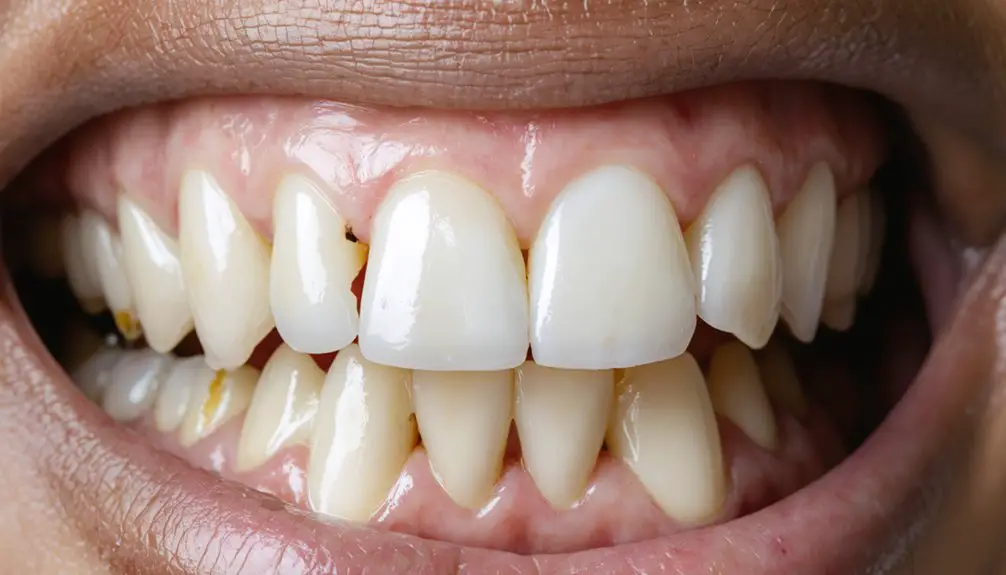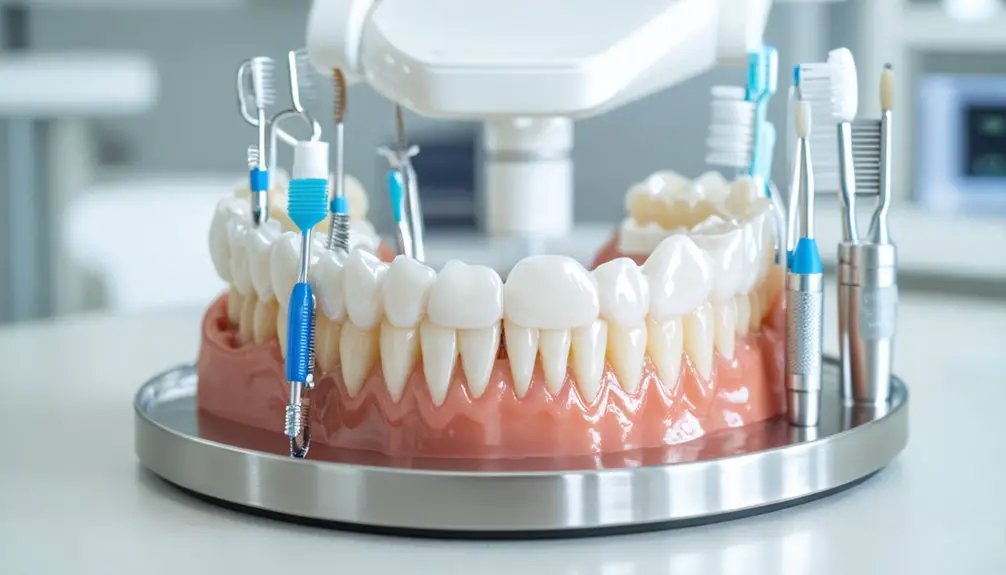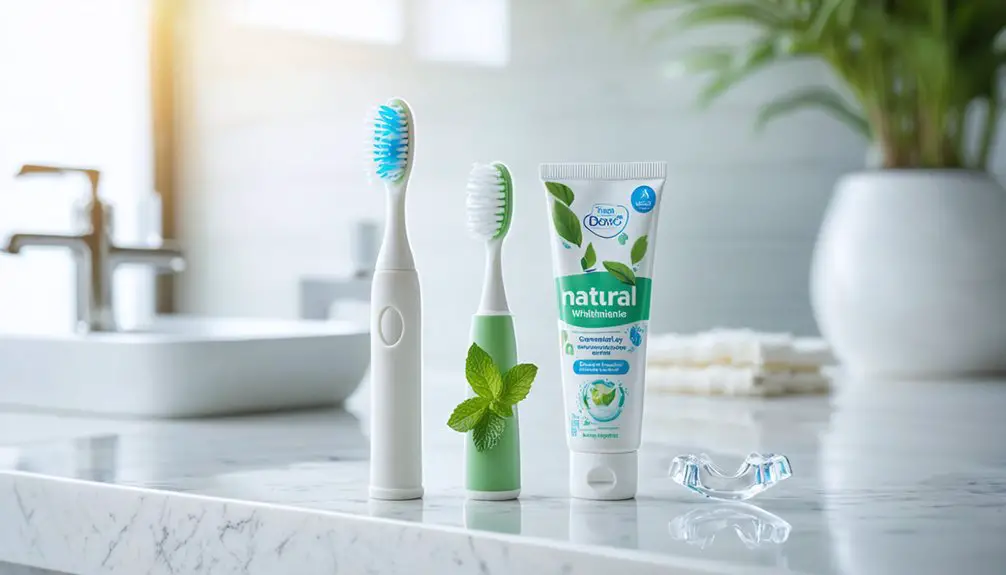If you have sensitive teeth, whitening treatments can increase your discomfort and potentially damage your dental health. The peroxide-based agents used in whitening can demineralize your enamel, expose nerve endings, and trigger intense sensitivity to hot, cold, and sweet substances. You’ll face higher risks if you have existing conditions like cavities, gum disease, or worn enamel. Understanding proper treatment options and preventive measures can help you achieve safer whitening results.
Key Takeaways
- Whitening treatments can worsen existing tooth sensitivity by increasing enamel porosity and exposing sensitive dentin layers to irritants.
- People with cavities, gum disease, or worn enamel face higher risks of severe pain and potential dental damage during whitening.
- High-concentration peroxide products can cause temporary or lasting nerve sensitivity, especially when used without professional supervision.
- Improper application of whitening products may lead to uneven results, chemical burns on gums, and increased tooth vulnerability.
- Aggressive whitening treatments can permanently damage tooth enamel, leading to chronic sensitivity and increased risk of decay.
Understanding Tooth Sensitivity During Whitening Treatment
When you undergo teeth whitening treatment, the bleaching agents used can temporarily disrupt your tooth structure and trigger sensitivity.
The peroxide-based whitening gels cause slight demineralization of your enamel, increasing its porosity and exposing the underlying dentin layer that contains nerve endings.
This process creates heightened nerve exposure through microscopic channels called dentinal tubules, which connect your tooth’s surface to its nerve center.
You’ll likely experience discomfort when consuming hot, cold, sweet, or acidic substances during and after treatment.
Using a higher concentration bleach during treatment significantly increases your risk of developing tooth sensitivity.
Modern whitening treatments often include anti-sensitivity agents to help minimize discomfort during the process.
While about 50% of patients report mild sensitivity, only 4% experience severe reactions.
The good news is that these effects are typically temporary – your tooth structure naturally remineralizes and sensitivity decreases once treatment ends, usually within 1-2 weeks.
Key Risks for Pre-Existing Dental Conditions
If you have pre-existing dental conditions, teeth whitening can pose significant risks that require careful consideration.
Cavities and gum disease can intensify sensitivity triggers during treatment, as whitening agents penetrate compromised enamel more easily. Your worn or thin enamel becomes particularly vulnerable to damage from peroxide-based products, potentially leading to permanent harm. Using desensitizing gels before treatment can help minimize discomfort and protect vulnerable teeth. Hot and cold foods can trigger increased discomfort during the recovery period.
Receding gums and periodontal issues increase your risk of tissue irritation and inflammation. Additionally, existing dental work won’t respond to whitening agents, potentially creating uneven coloring that affects your smile’s appearance.
Professional dental assessments are vital before proceeding with any whitening treatment. Without proper evaluation, you might inadvertently worsen underlying conditions, as whitening can mask symptoms while allowing bacterial invasion through increasingly permeable enamel.
Professional vs. At-Home Whitening Safety
Professional teeth whitening offers considerably greater safety measures compared to at-home treatments, particularly for those with sensitive teeth.
Professional dental whitening provides superior safety protections, especially for sensitive teeth, making it a more reliable choice than home treatments.
When you choose professional whitening, your dentist will assess your dental health, apply protective barriers, and monitor the entire process to prevent complications. They’ll also customize the treatment concentration and duration based on your sensitivity levels. Professional treatments typically include desensitizing agents to help minimize discomfort during and after the procedure. Treatment sessions are conducted in a safe environment and usually take 30-60 minutes to complete.
At-home kits, while more convenient, carry higher risks if you don’t follow instructions precisely.
You’re more likely to experience uneven results, gum irritation, or enamel damage through improper application or overuse. Without professional supervision, you mightn’t recognize early warning signs of sensitivity or tissue damage.
The controlled environment and expertise of professional whitening considerably reduce these risks, making it a safer choice for maintaining both the health and appearance of your teeth.
Managing Side Effects and Discomfort
Despite advances in whitening technology, sensitivity remains a common side effect that affects up to 78% of patients during treatment. Research indicates that peroxide concentrations above 35% significantly increase the risk of tooth sensitivity. For effective sensitivity management, you’ll need to take proactive steps to minimize discomfort while maintaining whitening results.
Studies show tooth sensitivity and irritation typically resolve within 3 days after stopping treatment. To achieve the best discomfort relief, use desensitizing toothpaste before and after treatments, and limit your exposure to whitening agents by choosing shorter, less frequent sessions.
You should avoid acidic foods and extreme temperature beverages during treatment periods. If you’re conducting at-home treatments, guarantee proper application technique to prevent soft tissue irritation, and thoroughly rinse afterward to remove residual agents.
For patients with thin enamel or previous dental work, consider lower peroxide concentrations and carefully monitor any sensitivity symptoms, which typically resolve within two weeks post-treatment.
Safe Practices for Sensitive Teeth Whitening
Successfully whitening sensitive teeth requires a strategic approach that balances effective stain removal with protective measures.
You’ll need to choose products specifically formulated with sensitivity protection, such as whitening toothpastes containing desensitizing agents like potassium nitrate and fluoride.
Focus on gradual whitening methods rather than aggressive treatments. Use over-the-counter strips with lower peroxide concentrations or professionally supervised treatments that customize the process to your sensitivity level. The active ingredients in whitening products like hydrogen peroxide can penetrate enamel and cause irritation if not properly managed. Individual whitening results vary based on the type and severity of tooth staining.
Schedule a dental evaluation before starting any whitening regimen to identify and treat underlying issues that could worsen with bleaching.
During treatment, follow product instructions precisely, allow interval breaks between applications, and use desensitizing toothpaste throughout the process.
Avoid combining whitening with other enamel-weakening products to prevent additional sensitivity.
Frequently Asked Questions
Can Whitening Treatments Permanently Damage Existing Dental Work Like Crowns or Fillings?
Like a gentle wave, whitening products rarely cause permanent damage to your dental work. However, you’ll need professional supervision to guarantee proper concentration and treatment duration for ideal safety and minimal impact.
How Long Should I Wait Between Whitening Sessions to Prevent Enamel Damage?
You’ll need to wait 1-2 weeks between whitening sessions to protect your enamel health. If you experience teeth sensitivity, extend this interval and consult your dentist for personalized timing recommendations.
Are Natural Whitening Alternatives Safer for People With Sensitive Teeth?
Natural remedies can be safer for your sensitive teeth since they’re gentler than chemical treatments, but you’ll still need to monitor your sensitivity levels and use them correctly to avoid damage.
Does Age Affect How Sensitive Teeth React to Whitening Treatments?
You’ll experience increased age-related sensitivity during whitening treatments as you get older since thinning enamel and exposed dentin make your teeth more vulnerable to whitening treatment effects and discomfort.
Can Certain Medications Increase Tooth Sensitivity During Whitening Procedures?
Yes, your medications can considerably affect tooth sensitivity during whitening. Drugs causing dry mouth, NSAIDs, and those impacting nerve responses create medication interactions that become powerful sensitivity triggers during treatment.
References
- https://www.dentistryofwestbend.com/teeth-whitening-risks-and-side-effects/
- https://pmc.ncbi.nlm.nih.gov/articles/PMC4058574/
- https://www.blvddentistry.com/can-you-get-whitening-treatment-with-sensitive-teeth/
- https://harrisburgsmilesdental.com/why-does-teeth-whitening-cause-sensitivity-understanding-the-basics/
- https://www.scottgreenhalghdds.com/blog/10-tips-for-dealing-with-sensitivity-after-teeth-whitening
- https://tooth-doctor.com/severe-tooth-sensitivity-after-teeth-whitening/
- https://crest.com/en-us/oral-care-tips/teeth-sensitivity/teeth-whitening-sensitivity-causes-how-to-avoid-it
- https://pubmed.ncbi.nlm.nih.gov/12198987/
- https://greenvillefamilydentistrysc.com/does-teeth-whitening-hurt/
- https://www.dentaris.com.mx/blog/what-are-the-side-effects-of-teeth-whitening-understanding-risks-and-precautions



